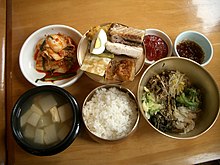Heotjesatbap
| Heotjesatbap | |
 | |
| Korean name | |
|---|---|
| Hangul | 헛제사밥 |
| Hanja | |
| Revised Romanization | Heotjesabap |
| McCune–Reischauer | Hŏtjesabap |
Heotjesa bap (Korean: 헛제사밥, also spelled hutjesa bap), a traditional Korean dish, is a variety of bibimbap, served with soy sauce (ganjang) instead of the gochujang (hot pepper paste) that is more commonly used. Hutjesa bab consists of mainly several types of namul (young sprouted vegetables) over white rice. It is also served with grilled fish and some jeon (Korean pancake).
The dish originated in Andong, Gyeongsang-do, a famous place where scholars lived and studied during the Joseon Dynasty. The term, Heotjesa bap literally means "dishes for fake jesa" that are ceremonies for death anniversary and ancestor veneration held in Korea. It is said that as there was insufficient foods during the period, some scholars in yangban class living in the region prepared ceremonial foods for fake jesa and enjoyed the dishes as well as commoners did.[1]
References
- ^ Info of Gourmet Restaurants at Jirye Village at KBS Global News
See also
External links
- Origin of Hutjesa bap at helloandong.go.kr
- Galler about Hutjesa bap at helloandong.go.kr
- Recipe of Hutjesa bap (in Korean) at Korean Tourism Organization
- Info of Hutjesa bap (in Korean) at Andong folk restaurant (안동민속민속의 집)
- Info of Hutjesa bap (in Korean) at What's on Korea
- Info of Hutjesa bap (in Korean)[칼럼-박진환의 음식이야기] 헛제사밥
